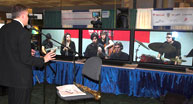Sleepless (but successful) in Seattle
Sleepless (but successful) in Seattle McGill University
User Tools (skip):
Sleepless (but successful) in Seattle
McGill team shines at prestigious Supercomputing 2005 competition
It is every middle manager's nightmare. You slave over your presentation for the big bosses day and night, herd them into the conference room on the Big Day, plug in your laptop and - fizzle - your PowerPoint goes belly up. Your blood pressure explodes like a cartoon thermometer and you wind up doing your presentation accompanied by shadow puppets on the wall.

Gordon Foote in Seattle instructs a McGill jazz ensemble in Montreal via ultra-videoconferencing.
Peter Marshall
Imagine, now, being John Roston, director, Instructional Multimedia Services, and Jeremy Cooperstock, professor in the Department of Electrical and Computer Engineering-co-leaders of the McGill contingent competing at the Supercomputing 2005 conference in Seattle this past October. The team was there as a last-minute entry in the Bandwidth Challenge, looking to unveil its ultra-videoconferencing system that promised to bring videoconferencing to an unparalleled level of interactivity.
Hooking up their space-age Shared Spaces system, complete with three 65" plasma screens that would display life-size, real-time high-definition images of colleagues back in Montreal, the team hit the switch and - you guessed it - nothing but fizzle.
Having arrived on Friday, October 11, the McGill team had been counting on using the weekend to debug their system before Monday's opening gala, especially important since they had never actually seen the project fully operational. With their system scheduled to be officially unveiled sometime in 2006, they only entered the competition after hearing rumours that a rival school was going to present a similar project.
Onsite technicians gave Roston the old good-news bad-news routine. The good news was that they had narrowed the problem down to a glitch in a fiber pair, the pipe that carries the data between the systems. The bad news; this fiber pair ran from Seattle to Montreal and the glitch could be anywhere along that line "That's a lot of anywhere," says Roston ruefully.
What followed was a series of technical snafus that saw the McGill delegation spending the entire weekend scrambling to have something other than shadow puppets ready to show. Finally, after the proverbial blood, sweat and tears, the system was deemed operational at 3 pm on Monday afternoon - just three hours before the opening gala.
Having hardly slept since their arrival, the McGill team booted the system and - voila - everything fell into place. On screen, a model train in Montreal chugged around its track. The resolution was so clear that people could read the lettering on the side of the model car and, when the train went over a bridge equipped with special transducers, people standing on a vibration platform in Seattle could feel the rumble. As well, crowd members were able to save a wayward cow by operating the train's switch signal whenever a collision seemed imminent. People were mesmerized.
"The big challenge of videoconferencing has always been the transmission delay," says Cooperstock, the engineering lead of the system's software. "People were blown away at how little delay there was." As word of the demonstration got round, hundreds of people began flocking to the booth, including heavyweights from the U.S. military, NASA and Hollywood's Dreamworks Studio.
Unlike many of the so-called bigwigs in the bandwidth competition, whose primary focus is to transmit huge quantities of raw data from one machine to another, McGill's approach is much more humanistic. "With the lack of delay and the high definition images, you stop thinking about the technology and start having a normal conversation with a person who is thousands of miles away," says Cooperstock. "We're all about facilitating communication between people." He and Roston see the Shared Spaces system being applied in such scenarios as long-distance teaching or remote surgical assistance in which a surgical expert looks over the shoulder of another during an operation from across the continent.
For the competition phase of the conference, the McGill team had Gordon Foote from the Schulich School of Music teach a jazz ensemble. The ability to interrupt students and exchange ideas with them in a timely, natural way did not go unnoticed by the judges. The pièce de résistance, however, was when Foote picked up his sax and started to play along with the other musicians - the first time this type of musical collaboration ever took place in North America using high-definition technology.
Sitting in the audience at the closing ceremonies, an exhausted Roston applauded when it was announced that Caltech, one of the biggest of the big boys, had won the Bandwidth Challenge. Unexpectedly, it was announced that the McGill team had won the award for the "Most Innovative Use of New Technology." Roston smiled; finally, a welcome surprise.

